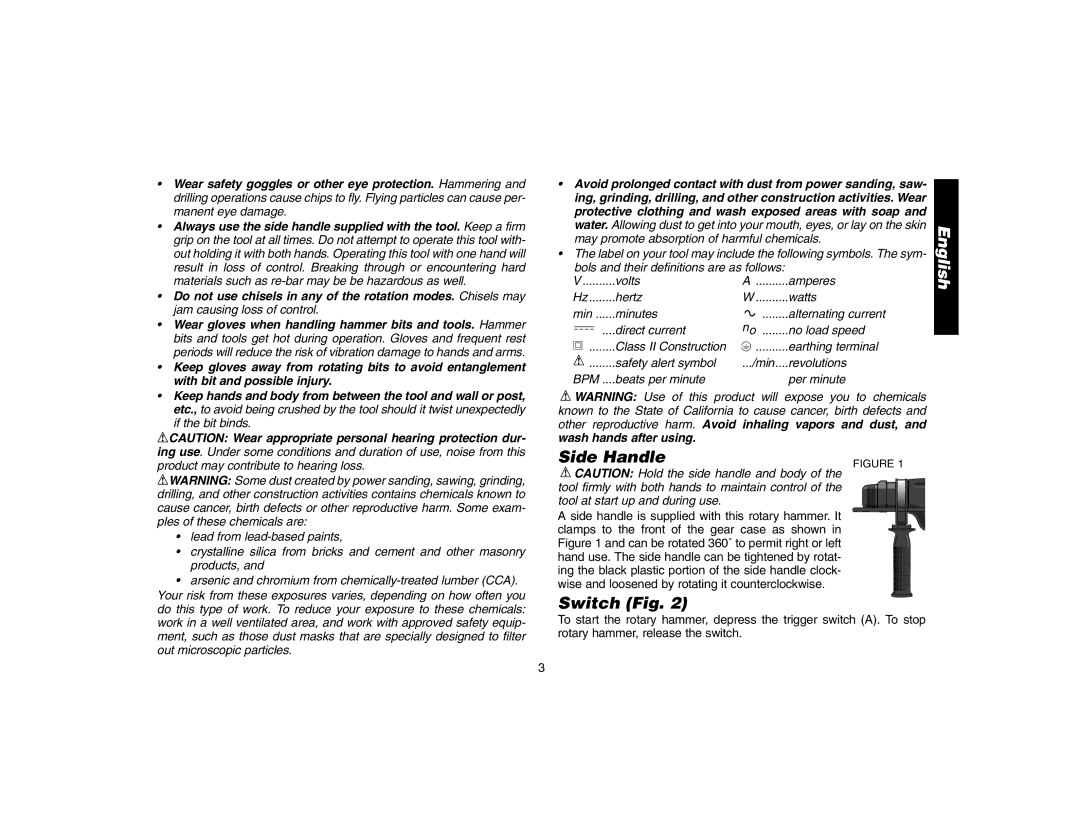
•Wear safety goggles or other eye protection. Hammering and drilling operations cause chips to fly. Flying particles can cause per- manent eye damage.
•Always use the side handle supplied with the tool. Keep a firm grip on the tool at all times. Do not attempt to operate this tool with- out holding it with both hands. Operating this tool with one hand will result in loss of control. Breaking through or encountering hard materials such as
•Do not use chisels in any of the rotation modes. Chisels may jam causing loss of control.
•Wear gloves when handling hammer bits and tools. Hammer bits and tools get hot during operation. Gloves and frequent rest periods will reduce the risk of vibration damage to hands and arms.
•Keep gloves away from rotating bits to avoid entanglement with bit and possible injury.
•Keep hands and body from between the tool and wall or post, etc., to avoid being crushed by the tool should it twist unexpectedly if the bit binds.
![]() CAUTION: Wear appropriate personal hearing protection dur- ing use. Under some conditions and duration of use, noise from this product may contribute to hearing loss.
CAUTION: Wear appropriate personal hearing protection dur- ing use. Under some conditions and duration of use, noise from this product may contribute to hearing loss.
![]() WARNING: Some dust created by power sanding, sawing, grinding, drilling, and other construction activities contains chemicals known to cause cancer, birth defects or other reproductive harm. Some exam- ples of these chemicals are:
WARNING: Some dust created by power sanding, sawing, grinding, drilling, and other construction activities contains chemicals known to cause cancer, birth defects or other reproductive harm. Some exam- ples of these chemicals are:
•lead from
•crystalline silica from bricks and cement and other masonry products, and
•arsenic and chromium from
•Avoid prolonged contact with dust from power sanding, saw- ing, grinding, drilling, and other construction activities. Wear protective clothing and wash exposed areas with soap and water. Allowing dust to get into your mouth, eyes, or lay on the skin may promote absorption of harmful chemicals.
•The label on your tool may include the following symbols. The sym-
bols and their definitions are as follows: |
| ||||||
V | volts | A | amperes | ||||
Hz | hertz | W | watts | ||||
min | minutes | no | alternating current | ||||
|
|
| ....direct current | no load speed | |||
|
|
| |||||
| ........ | Class II Construction |
|
| .......... | earthing terminal | |
|
|
|
|
|
| ||
|
|
|
|
|
| ||
| ........ | safety alert symbol | .../min.... | revolutions | |||
BPM | ....beats per minute | .............. |
|
| per minute | ||
![]() WARNING: Use of this product will expose you to chemicals known to the State of California to cause cancer, birth defects and other reproductive harm. Avoid inhaling vapors and dust, and wash hands after using.
WARNING: Use of this product will expose you to chemicals known to the State of California to cause cancer, birth defects and other reproductive harm. Avoid inhaling vapors and dust, and wash hands after using.
Side Handle | FIGURE 1 | ||||||
CAUTION: Hold the side handle and body of the | |||||||
|
|
|
|
|
| ||
tool firmly with both hands to maintain control of the |
|
|
|
|
|
| |
|
|
|
|
|
| ||
tool at start up and during use. |
|
|
|
|
|
| |
A side handle is supplied with this rotary hammer. It clamps to the front of the gear case as shown in Figure 1 and can be rotated 360˚ to permit right or left hand use. The side handle can be tightened by rotat- ing the black plastic portion of the side handle clock- wise and loosened by rotating it counterclockwise.
Switch (Fig. 2)
To start the rotary hammer, depress the trigger switch (A). To stop rotary hammer, release the switch.
English
3
